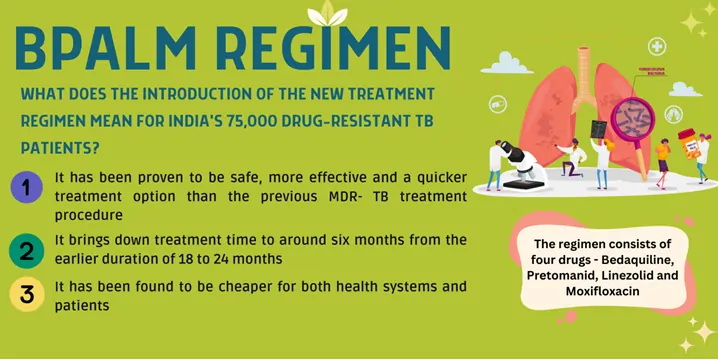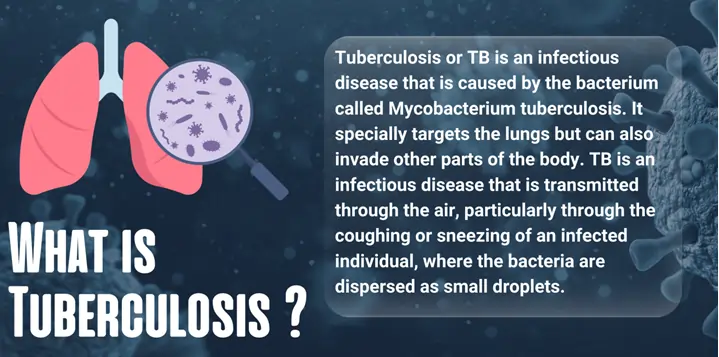Union Health Ministry approves introduction of new shorter and more effective treatment regimen for multidrug-resistant tuberculosis (MDR-TB) in India. The Union Ministry of Health and Family Welfare has approved the introduction of BPaLM regimen as a highly effective and short-term treatment option for multidrug-resistant TB (MDR-TB) under the National TB Elimination Programme (NTEP). The Objective is to make India TB free by 2025. India is aiming to done it five years prior to SGD goals.

What is BPaLM regimen?
- BPaLM regimen is a treatment regimen developed for the treatment of MDR-TB that combines four drugs - bedaquiline, pretomanid, linezolid and moxifloxacin.
- This treatment method has proven to be safer, more effective and faster treatment option than the previous MDR-TB treatment method.
- Conventional MDR-TB treatment lasts up to 20 months with severe side effects. Whereas, the BPALM treatment method can cure MDR-TB in just six months and the treatment success rate is also high.
- The Department of Health and Family Welfare has also conducted a health technology assessment through the Department of Health Research to ensure that the BPALM treatment method is a safe and affordable treatment option for MDR-TB. Multi-drug resistant TB (MDR-TB)
- Multidrug-resistant tuberculosis (MDR-TB) is a stage of TB disease when the tuberculosis bacteria are not affected by at least two very powerful first line anti-tuberculosis drugs isoniazid and revamping, that is, the bacteria develop resistance.
- The problem of MDR TB is most commonly seen in old TB patients. Patients who have mismanagement of medicines in their treatment such as not completing the course, taking TB medicines in the wrong way, not taking medicines regularly and taking poor quality medicines etc. are at the highest risk of getting MDR TB. A healthy person can also suffer from MDR-TB due to coming in contact with an MDR-TB patient.
What is the National TB Elimination Program (NTEP)?
The National TB Elimination Programme (NTEP) is a public health initiative of the Government of India organized to eliminate tuberculosis. The National Tuberculosis Elimination Programme (NTEP), also previously known as the Revised National Tuberculosis Control Programme (RNTCP), is a strong public health programme implemented by the Government of India.
Historical Evolution: The journey started as early as 1962 when the Indian Government started the National TB Program where District TB Centres were set up.The program was revamped in 1997 and therefore became called, the Revised National Tuberculosis Control Programme RNTCP. This phase saw the introduction of the DOTS (Directly Observed Treatment Short course) regime.In subsequent years, there was change that was done on the program. Like notifying TB and molecular test were important part in NSP2012-17.Finally, what was known as the RNTCP was formally renamed the National TB Elimination Program in January 2020 to reflect its ambitious new mission: tuberculosis elimination by 2025.
Key Objectives:
- Find All TB Cases: NTEP attaches great importance to finding all the TB patients, including those in the private sector.
- Treat All TB Cases: The tested cases receive high quality anti-TB drugs.
- Prevent Emergence of TB: It is a primary preventative program designed to prevent the occurrences of Tuberculosis in vulnerable populations of people.
- Stop Catastrophic Expenditure: Given the above reasons, NTEP has effectively hindered families from suffering financial losses due to TB related costs by providing adequate TB care.
- Build Supportive Systems: It entails policy formulation, institution building and the provision of adequate human capital.
TB Burden in India: Tuberculosis is a significant problem in India. According to estimate there were about 26.4 lakh TB cases in 2019.The disease cuts across all age groups in the population, it is found in men, women and children.TB is present in both urban and rural regions, and attempts are made to address the problem in tribal regions.Furthermore, drug-resistant TB and TB-HIV co-infection create extra difficulty.
India’s Commitment: India has committed to the End TB strategy and set its sights on reaching zero TB by 2025 despite the global Sustainable Development Goals.To this commitment, seventeen of the regional authorities have formulated precise strategic frameworks or road maps.
Road to Realizing a TB-Free India: NTEP envisions several scenarios:
- Scenario 01: Continued service delivery utilizing the available tools as of now.
- Scenario 02: Scale-up of prevention and control for the entire population.
- Scenario 03: Key interventions: non-health interventions (e.g., dealing with under-nutrition, poverty, and housing) and vaccines/immunization interventions.
To sum it up, the NTEP is a ray of hope in the war against TB. Together, they include active case finding, new drug regimens, private sector partnership, and Information Technology surveillance to fuel a TB-free India.
Challenges faced by NTEP
Tuberculosis is a serious health issue across India, where the National Tuberculosis Elimination Program (NTEP) has been operating relentlessly:
- High TB Burden: TB is still a major concern in the health sector of India. India has the highest burden of TB in the world; it impacts people of all ages. The causative agent of TB is Mycobacterium tuberculosis, a highly infectious bacterium that is spread through droplet infection. Over a million people die from TB each year, and a large number of these deaths occur in India.
- Drug Resistance: Multidrug resistance remains a critical threat due to the emergence of drug-resistant TB strains. Managing DR-TB is much more challenging in time and cost. TB disease becomes very complex with the development of MDR and XDR strains, making it very difficult to control its spread.
- Co-Infection with HIV: TB-HIV co-infection still remains a major challenge. TB especially is more prevalent among people living with HIV and its management can only be achieved through a combined approach with HIV.
- Socio-Economic Barriers: This disease is still very much prevalent due to poverty, malnutrition and cramped living conditions in some regions. These socio-economic factors affect early diagnosis, proper compliance to treatment, and overall management of the disease.
- Access to Healthcare: Achieving this will is important for making certain that as many people as possible can access quality health care services. Most at risk groups, particularly those in the rural settings for instance, have difficulty in getting to the facilities in time.
- Engaging Informal Healthcare Providers: NTEP does involved formal healthcare providers, however contacting informal ones like local practitioners and traditional healers remains an empty space. These providers may act as the initial contact for care in numerous communities, and their participation could improve identification and intervention.
What strategies is NTEP employing to tackle these challenges?
The National Tuberculosis Elimination Programme (NTEP) operating in India has been tirelessly striving to fight against TB and to overcome all the difficulties in relation to this infectious illness. Let’s delve into some of the strategies they’ve employed:
National Strategic Plan for Tuberculosis (2017-2025):
NTEP has developed a detailed strategic plan that covers from the year 2017 to the year 2025. This plan outlines both short-term and long-term goals, aiming for TB elimination by 2025.Some key components include:
- Case Finding: Increased efforts in case finding and early diagnosis of TB.
- Treatment Services: The objective of providing standard anti-TB drugs is to ensure that all diagnosed TB patients will receive effective quality treatment.
- Patient Support Systems: Enhancing structures to integrate the patient throughout the continuum of care.
- Airborne Infection Control: Measures to control the spread of the TB especially in the communities.
- Urban TB Control: How to best tackle the disease in urban populations more so where it is more rampant.
- Health System Strengthening: Strengthen the function of the entire health system in dealing with TB.
- Advocacy and Communication: Capacity building and the promotion of awareness and organized communities.
- Research and Technical Assistance: Promoting research in the field and consulting technical professionals.
Treat All TB Cases with High-Quality Drugs:
According to the NTEP it is important to effectively manage all cases of TB by using appropriate anti-tuberculosis drugs. This fosters the aspect of pulling everyone up and nobody is left untreated in a given population.They also target TB in high risk groups which are essential in the fight against this disease since it can easily spread within such groups.
- Supportive Systems and Policies: The NTEP acknowledges how it is crucial to establish and develop environments that are supportively adequate. This involves adoption of supportive polices, strengthening of institutions and availability of sufficient workforce for effective TB control.
- Structured Review and Analysis: This is a systematic process by NTEP to put into place an appraisal and evaluation procedures of the activities implemented in the campaign against TB. It also helps them to reshape and fine tune their efforts purposefully.
Tuberculosis (TB): A Brief Overview
Tuberculosis or TB is an infectious disease that is caused by the bacterium called Mycobacterium tuberculosis. It specially targets the lungs but can also invade other parts of the body. TB is an infectious disease that is transmitted through the air, particularly through the coughing or sneezing of an infected individual, where the bacteria are dispersed as small droplets.

Symptoms:
- Chronic cough, defined as cough for more than 21 days but less than three months
- Chest pain
- Fatigue
- Fever
- Night sweats
- Unintended weight loss
Transmission: TB is highly contagious. Transmission of the disease is likely to occur when one is in contact with an infected person. Nevertheless, all the individuals who were exposed to TB bacteria do not get sick; they may develop latent TB infection, which is non-active in most cases.
Diagnosis: Screening for latent TB using tuberculin skin test (TST) or interferon-gamma release assay (IGRA).Pulmonary examination through chest x rays and sputum for active TB.
Treatment: TB can be cured using anti TB drugs. This requires the intake of one, two or three antibiotics (most commonly isoniazid, rifampicin, pyrazinamide and ethambutol) daily for months.It is therefore important to ensure that patients follow through and complete the full regimen to avoid development of drug resistance.
Challenges: Cases of people developing Tuberculosis that is resistant to these drugs are on the Increase, this is dangerous.Social isolation can make patients remove their TB clothes when out of hospital and this discourages early presentation and admission.
Prevention: BCG (Bacillus Calmette-Guérin) vaccine offers an incomplete immunity to the bacteria that cause TB.Hand hygiene, personal protective equipment, environmental cleaning, and isolation Precautions in healthcare environment.
Global Impact: TB is still a leading cause of mortality globally with the majority of deaths being recorded.Measures taken to control TB include; diagnosis and treatment, as well as community health.